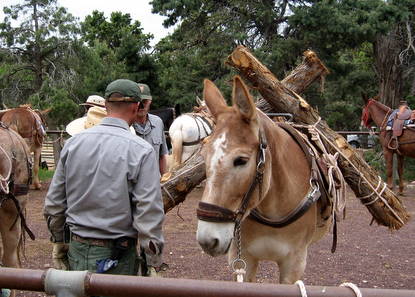|

National Park Service
Contact: Maureen Oltrogge, 928-638-7779 Grand Canyon, Ariz. - On Tuesday, June 9, 2009, the National Park Service began a project to reconstruct the South Kaibab Trail in Grand Canyon National Park. The project is one of the largest reconstruction projects on a Grand Canyon trail since the mid 1960s and will be funded, in part, with funds from the American Recovery and Reinvestment Act of 2009 (ARRA). The project is one of many National Park Service Recovery projects that was selected after a review of all pending construction, maintenance, and rehab/repair projects through a rigorous process to identify those that were not only priorities but also met the specific ARRA criteria. Grand Canyon National Park is renowned for its trails. The park has more than 630 miles of trails, including 415 miles of inner canyon backcountry trails and 42 miles of inner canyon corridor trails. Corridor trails include Bright Angel Trail, the River Trail, and the South and North Kaibab Trails, all of which comprise the inner canyon corridor from South to North Rim. Over 200,000 visitors use these trails on an annual basis. The reconstruction of the South Kaibab Trail will take approximately two to four years and will cost several million dollars to complete. Grand Canyon National Park received approximately $10.8 million in ARRA funds, of which $550,000 will go towards the reconstruction of the South Kaibab Trail. The South Kaibab Trail begins on the South Rim near Yaki Point and descends to the Colorado River. The distance from the trailhead to Phantom Ranch is approximately 7.5 miles with an elevation change from rim to river of 4860 feet. The reconstruction project will significantly improve the condition of the trail for both hikers and stock users alike. The reconstruction effort will include resurfacing of the trail; rebuilding steps; stabilization and preventative maintenance to existing retaining walls; replacing retaining walls that have been lost to floods, slides, or erosion; repairing and aligning existing water features; and more. The money will allow the National Park Service to extend 28 trail crew members that would have normally been furloughed; as well as purchase necessary equipment and supplies for trail reconstruction. A majority of the work that will be conducted on the trail is repair and replacement of stonework that is historically significant and requires master-level masonry skills and a background in historic preservation of masonry structures. Recovery funds will make it possible to extend employment of the young men and women that have the skill level needed to adequately perform this work. Offering their expertise and helping the National Park Service with trail work in the park are the American Conservation Experience (ACE) and Coconino Rural Environmental Corps (CREC), both from Flagstaff, Arizona. These crews are being paid with funds from entrance fees collected under the Federal Lands and Recreation Enhancement Act. “Grand Canyon has total deferred maintenance of over $262 million, of which over $24 million is attributed to Grand Canyon trails,” stated park superintendent, Steve Martin. Adding, “Funding provided through the American Recovery and Reinvestment Act of 2009 will help us reduce the park’s deferred maintenance, and begin to rebuild park trails to a safer standard and create a lasting value for the American People.” To address the issue of how best to complete reconstruction work, the National Park Service made a decision to temporarily divert commercial and private stock traffic to the Bright Angel Trail during construction activities for the safety of stock users and hikers alike, as well as to save costs by reducing the time it will take to reconstruct the trail. The South Kaibab Trail will remain open to hikers during trail reconstruction; however, occasional short delays may occur – hikers will be advised to follow instructions provided by trail crew members, or through signing and other advisories. Additional Grand Canyon projects selected under ARRA include repair of North Rim trails and trail structures damaged by wildfire; preservation treatment on 130 miles of roads; improvements to wastewater flow meters to increase visitor health and safety; rehabilitation of historic South Rim housing; repair and rehabilitation of housing at Supai Camp (an area established in the 1920’s as a permanent location for the local members of the Havasupai Tribe to maintain a residential area in the vicinity of the South Rim Village) as well as the rehabilitation of two non-historic structures at the Camp; rehabilitation of HVAC systems in the park’s Fee Management Office and Visitor Center; replacement of shingles on South Rim housing units; replacement of doors on historic South Rim Facilities as well as painting the facilities to improve energy efficiency and appearance; and purchase of five new alternative fuel transit buses. For more information about ARRA projects and contracting/job information, please visit www.doi/gov/recovery. For more information about Grand Canyon National Park, please visit www.nps.gov/grca, or call 928-638-7888. |
Last updated: February 24, 2015
